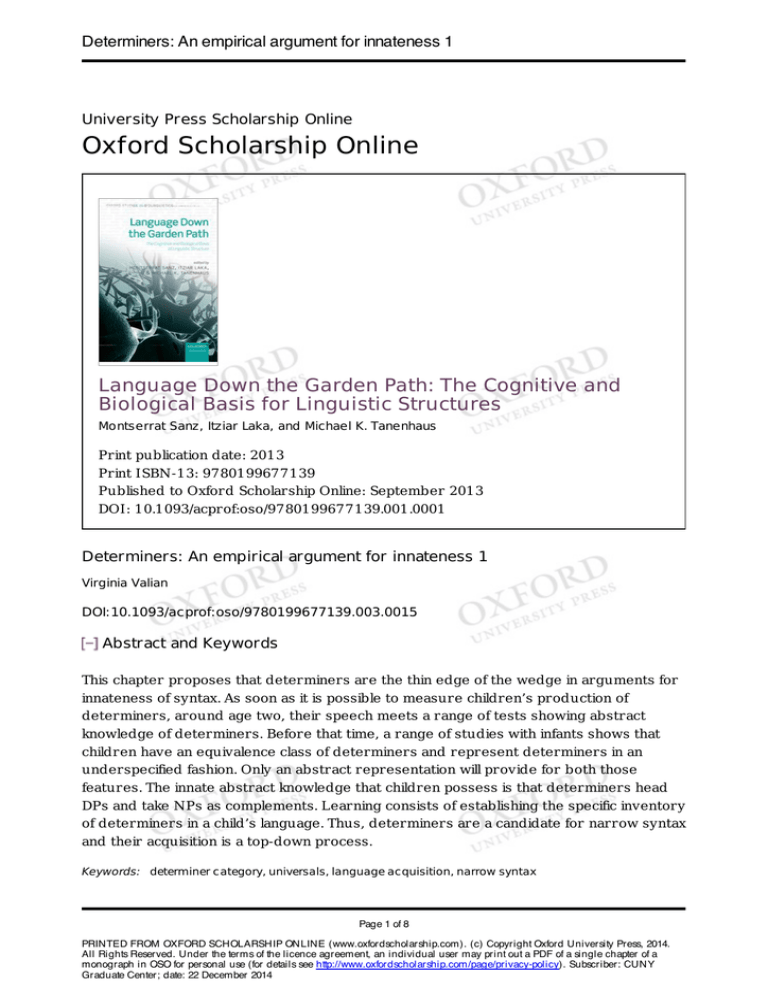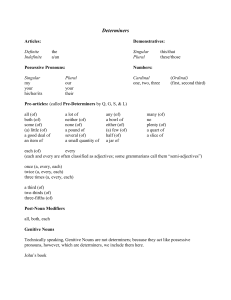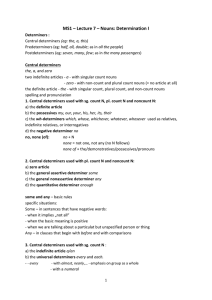
Determiners: An empirical argument for innateness 1
UniversityPressScholarshipOnline
OxfordScholarshipOnline
LanguageDowntheGardenPath:TheCognitiveand
BiologicalBasisforLinguisticStructures
MontserratSanz,ItziarLaka,andMichaelK.Tanenhaus
Printpublicationdate:2013
PrintISBN-13:9780199677139
PublishedtoOxfordScholarshipOnline:September2013
DOI:10.1093/acprof:oso/9780199677139.001.0001
Determiners:Anempiricalargumentforinnateness1
VirginiaValian
DOI:10.1093/acprof:oso/9780199677139.003.0015
AbstractandKeywords
Thischapterproposesthatdeterminersarethethinedgeofthewedgeinargumentsfor
innatenessofsyntax.Assoonasitispossibletomeasurechildren’sproductionof
determiners,aroundagetwo,theirspeechmeetsarangeoftestsshowingabstract
knowledgeofdeterminers.Beforethattime,arangeofstudieswithinfantsshowsthat
childrenhaveanequivalenceclassofdeterminersandrepresentdeterminersinan
underspecifiedfashion.Onlyanabstractrepresentationwillprovideforboththose
features.Theinnateabstractknowledgethatchildrenpossessisthatdeterminershead
DPsandtakeNPsascomplements.Learningconsistsofestablishingthespecificinventory
ofdeterminersinachild’slanguage.Thus,determinersareacandidatefornarrowsyntax
andtheiracquisitionisatop-downprocess.
Keywords:determinercategory,universals,languageacquisition,narrowsyntax
Page 1 of 8
PRINTED FROM OXFORD SCHOLARSHIP ONLINE (www.oxfordscholarship.com). (c) Copyright Oxford University Press, 2014.
All Rights Reserved. Under the terms of the licence agreement, an individual user may print out a PDF of a single chapter of a
monograph in OSO for personal use (for details see http://www.oxfordscholarship.com/page/privacy-policy). Subscriber: CUNY
Graduate Center; date: 22 December 2014
Determiners: An empirical argument for innateness 1
14.1Whydeterminers?
Myaiminthispaperistooutlineanempiricalargumentforinnatesyntax,using
determinersasacasestudy.Therearefourreasonsforthechoiceofdeterminers.
(1)Everymodelofacquisitionincludestheeventualpresenceofsyntacticcategories,
includingdeterminers,inthechild’sgrammar.Agreementontheendpointavoidsthe
objectionthatagivenlinguisticprincipleorstructureisneverpartofaspeaker’s
grammarandthusneedsnoexplanationand,afortiori,needsnoinnatestructureto
accountforitsacquisition.Argumentswillbefocusedonhowthechildgetstotheend
point,notonwhattheendpointconsistsof.
(2)Determiners,unlikenounsandverbs,arelessdirectlytiedtoreference.Determiners
haveasemanticsandapragmatics,butfullknowledgeofthepragmaticsseemstoappear
after,ratherthanbefore,thesyntaxofdeterminers(ModyanovaandWexler2007).
Moregenerally,Naigles(2002)hasarguedconvincinglythatexperimentsthatappearto
showlackofsyntacticknowledgeactuallyinsteadshowdifficultywithsemantics.
(p.273) (3)Two-year-oldsattheonsetofcombinatorialspeechalreadyhave
determinersintheirgrammar(Valian,Solt,andStewart2009).
(4)Itispossibletotracethedevelopmentofdeterminersfrompre-verbalinfancy
throughagetwo.Thattrajectoryisnotknownforanyothercategory.
14.2Whatisinnateandwhatislearned?
Ifdeterminersareinnate,whatexactlyisinnatelyspecified?Asafirstapproximation,I
proposeanabstractschematicrepresentation,underspecifiedwithrespecttodetails:(1)
determinersareheadsofdeterminerphrases;(2)determinerstakenounphrasesas
theircomplements.Inaddition,(3)determinersandnounscanbeinanagreement
relation.Ifanounissingular,forexample,thedeterminerusedwithitcanbesingularor
unspecifiedwithrespecttonumber,butcannotonlybeplural.InEnglishitispossibleto
sayaballortheball,butnotmanyball.Insomelanguages,determinersandnouns
agreeingender;femininenounstakethefeminineformofadeterminer.
Asisevidentfromtheschema,determinersarethethinedgeofthewedge.To
hypothesizeeventhebareminimumaboutdeterminersrequiresreferencetoother
syntacticnotions,suchas“head,”“complement,”“agreement,”andreferencetoother
syntacticcategories.Becauselanguagesaredescribedbyaninterlockingsetofconcepts,
andbecauselanguagerepresentsanindependentdomain,nosyntacticnotioncanbe
definedindependentlyofothernotions.
Thedeterminerschemaleavesmanyofthechild’slearningproblemsuntouched.For
example,thechildmustlearnwhatthespecificdeterminersinherlanguageare.In
English,possessivepronouns,likemy,actlikedeterminers,butinItaliantheyactlike
adjectives.Thechildhastolearnthecontentsoftheequivalenceclassofdeterminers
languagebylanguage.
Page 2 of 8
PRINTED FROM OXFORD SCHOLARSHIP ONLINE (www.oxfordscholarship.com). (c) Copyright Oxford University Press, 2014.
All Rights Reserved. Under the terms of the licence agreement, an individual user may print out a PDF of a single chapter of a
monograph in OSO for personal use (for details see http://www.oxfordscholarship.com/page/privacy-policy). Subscriber: CUNY
Graduate Center; date: 22 December 2014
Determiners: An empirical argument for innateness 1
Anotherlearningproblemthechildfacesisfiguringoutinwhichcontextsadeterminer
mustbeused,and,ifonemustbeused,figuringoutwhichonetouse.InEnglish,ashifts
totheincertaincontexts.InEnglish,barepluralnounsaregrammaticalbutbaresingular
countnounsarenot;inotherlanguages,evenpluralnounsrequiredeterminers;
semanticsisnohelphere.
Athirdlearningproblemisfiguringouttheparticularfeaturesthatdeterminershaveina
language.Englishdoesnotmarkgender,butFrenchandSpanish,forexample,do.
Thecrucialfeatureofthisproposalisthatthechildstartsoffwithanabstractconceptand
learnsdetails.Contrastingtheoriesproposethatthechildstartsoffwithdetailsand
constructsanabstractconcept(e.g.,PineandLieven1997;Abbott-SmithandTomasello
2006).
(p.274) 14.3Whendoesthechild’sgrammarincludedeterminers?
Usingsixdifferenttestsofknowledge,Valian,Solt,andStewart(2009)concludethat
childrenrepresentdeterminersintheirgrammarattheonsetofcombinatorialspeech
(roughlyages1year10months–1;10–2;2).Thetestswereadaptedfromprevious
studiesarguingagainst(Eisenbeiss2000;PineandLieven1997;PineandMartindale
1996)orinfavorofearlyknowledgeofdeterminers(Valian1986),usingalargersample,
improvedmethods,andanewwayofstratifyingthedata.
TheValiancorpuscontainsspeechfrom21child–motherpairs.Thechildrenrangeinage
from1;10(1year10months)to2;8andtheirspeechrangesinaverageutterancelength
from1.53–4.58morphemes.Thereareapproximately1.5hoursofspeechperpairand
764utterancesperchild.Thesizeofthecorpus,bothintermsofnumberofchildrenand
intermsofnumberofutterancesperchild,makesitpossibletoseparateissuesof
competenceandperformanceandtoshowhowresearcherscoulddrawmisleading
conclusions.
Oneimportanttestwastheextenttowhichthechildusedmorethanonedeterminer
beforeagivennountype(PineandMartindale1996)andthedegreeofdifference
betweenthechildandhisorherparent.Forexample,didthechildusethenounballonly
witha(oronlywiththe),orwithbothaandthe?Didthechild’sproductivityinthissense
differfromtheparent’s?Theshortansweristhatallchildren,eventhoseatlowMLUs,
usedavarietyofdeterminersbeforetheirnouns,anddidsotothesameextentthat
theirparentsdid,whetherthetestwasconfinedtoaandtheorincludedalldeterminers,
andwhetherthechildandparentwerematchedondeterminer–nounpairsornot.
Themostimportantfindingwasastratificationanalysisthatshowedhowonecould
mistakenlythinkthatveryyoungchildrenarenotproductiveintheiruseofdeterminers.
Considerthecasewhereachildusesaparticularnounonlyonce.Bydefinition,itis
impossibleforthechildtousemorethanonedeterminerwiththatnoun.Onlywhena
childusesanounseveraltimeswithadeterminerwillitbepossibletoseewhethershe
usesmorethanonedeterminerwithsuchanoun.Previousanalysesdidnotstratify
nounsforthenumberoftimestheyoccurredwithadeterminer.Theythusrantherisk,
Page 3 of 8
PRINTED FROM OXFORD SCHOLARSHIP ONLINE (www.oxfordscholarship.com). (c) Copyright Oxford University Press, 2014.
All Rights Reserved. Under the terms of the licence agreement, an individual user may print out a PDF of a single chapter of a
monograph in OSO for personal use (for details see http://www.oxfordscholarship.com/page/privacy-policy). Subscriber: CUNY
Graduate Center; date: 22 December 2014
Determiners: An empirical argument for innateness 1
especiallywithsmallnumbersofutterancesperchild,ofconsideringmanynounsused
onlyonceortwicewithadeterminerandthusartifactuallyconcludingthatthechildwas
notproductivewithherdeterminers.
AsFigure14.1shows,howoftenanounappearswithadeterminerisdirectlyrelatedto
overlap―theextenttowhichachildusesmorethanone(p.275)
FIGURE14.1. Productivity(overlap)indetermineruseasa
functionofopportunitytodiscoveroverlap
determinerwithagivennoun.Failuretofindoverlapistheexperimenter’sfailure,not
thechild’s.Oneneedsalargeenoughsampletoseparatehowoftenanounisusedwitha
determiner.Iftherearetoofewcaseswhereanounisusedfrequentlywitha
determiner,theopportunitytodetectproductivityiscorrespondinglylow.
Therewasnoevidenceofdevelopmentinthesyntacticstructureunderlyingchildren’s
determinerusage.Oncethereissufficientopportunitytodetectproductivity,thechild’s
MLUdoesnotpredictoverlap.
Childrenalsoshowednoevidenceofearlyrelianceonformulae,suchaswhat’sthe___?
Onthecontrary,childrenusedsuchphrasalformulaemorewithincreasingMLU.
Finally,childrenmadealmostnoerrorsintheiruseofdeterminers,verifyingprevious
research(Abu-Akel,Bailey,andThum2004;IhnsandLeonard1988;Valian1986).
Whatdidchangeaschildren’sMLUincreasedwasthenumberofdifferentdeterminers
intheirrepertoireandhowoftentheyusedthem.Therewasnodevelopmentinthe
natureoftheirdeterminerusage.
Byagetwo,then,childrenshowabstractknowledgeofdeterminers.Thedevelopmentin
productivitycanbeattributedtodevelopmentinthenumberofknowndeterminersand
inthenumberoftimesanounisusedwithadeterminer.Children’searlyusesshow,if
anything,fewerformulaethantheir(p.276) parents’usesdo.Thechildrenarefaithfulto
distributionalregularities.Alinguist,facedwiththisunknownlanguage,wouldconclude
thatithaddeterminers.Onlythesparsedataproblem―smallsamplesand,withineach
Page 4 of 8
PRINTED FROM OXFORD SCHOLARSHIP ONLINE (www.oxfordscholarship.com). (c) Copyright Oxford University Press, 2014.
All Rights Reserved. Under the terms of the licence agreement, an individual user may print out a PDF of a single chapter of a
monograph in OSO for personal use (for details see http://www.oxfordscholarship.com/page/privacy-policy). Subscriber: CUNY
Graduate Center; date: 22 December 2014
Determiners: An empirical argument for innateness 1
sample,fewnounsbeingusedmultipletimeswithadeterminer―preventsthat
conclusion.Whenthesparsedataproblemissolved,children’sproductivityisapparent.
Developmentoccurs,butafteragetwoitislimitedtoanincreaseinthenumberof
determinertypesandthefrequencyofdetermineruse.
14.4Isthedevelopmentaltrajectorycontinuousordiscontinuous?
Anaccountonwhichaschematicrepresentationofdeterminersisinnatepredicts
continuity.Developmentconsistsoffleshingouttheschema,intwoways.First,thechild
learnswhatcountsasadeterminer.InEnglish,forexample,thechildlearnsthata,the,
andsomeareinthedeterminerclass.Second,thechildlearnsaboutthelanguagespecificparticularsofeachdeterminer’sbehavior.InEnglish,shelearnsthatais
restrictedtosinglecountnouns,thecanbeusedwithanycountormassnoun,andsome
canbeusedwithpluralcountnounsandmassnouns.Themodelpredictscontinuity:the
child’sgrammariscommensuratewiththeadult’s;thechilddoesnotshiftfromone
systemofrepresentationtoanothernordoessheshiftfromnorepresentationto
representation.
Oneformofevidenceforcontinuityisunderspecificationoftheclassofdeterminers.
Thatis,thechildhasnotfullyanalyzedthespecificsoftheinput,contrarytowhata
completelyinput-drivenmodelwouldpredict.Determiners,becauseoftheirhigh
frequency,shouldbehelpfultochildreninsegmentingspeechbyactingasanchorpoints,
asValianandCoulson(1988)proposed.Butinsegmentingthespeechstream,thechild
mighttreattheandthenonsensedeterminerkuhasequivalentbecausekuhretainsthe
highlyfrequentschwa,eventhoughthechildhasneverheardkuh.Or,inFrench,the
childmightacceptbothleandlaasinterchangeable,failingtodistinguishtheirgender.As
longashighlyfrequentdeterminershavefewsound-alikecompetitors,theyshouldhelp
infantstoprocessspeech.
Anexampleofphoneticunderspecificationcomesfromacomparisonofeight-andelevenmonth-olds’abilitytouserealvsnonsensedeterminerstosegmentanonsensenoun
fromitsprecedingdeterminer(Shi,Cutler,Werker,andCruickshank2006).Infants
hearddeterminer–nounpairshalfthetimewithahigh-frequencyrealdeterminer(e.g.,
thetink)andhalfthetimewithaphonologicallysimilarnonsensedeterminer(e.g.,kuh
breek).Otherinfantsheardlow-frequencydeterminers,hervsler.
(p.277) Ifinfants’firstrepresentationsaretiedtospecificwords,thentheyshouldbe
equallyunabletosegmentnonsensewordsliketinkandbreek(i.e.,equallyunableto
recognizethemwhentheyarepresentedinisolation),whethertheyareprecededbythe
orkuhduringfamiliarizationtrials.Sincetheyhaveneverheardtinkbefore,theyhave
alsoneverheardthesequencethetinkbefore.Althoughtheinfantshaveheardthe
before,iftheistiedintheirrepresentationsonlytonounstheyhavepreviously
encountered,thesequencethetinkshouldbeperceivedasasingletwo-syllableword;
theshouldnothelpthechildrecognizetinkasaseparateword.Sincethechildrenhave
neverheardkuhbefore,theyshouldsimilarlyperceivekuhtinkasasingletwo-syllable
word.
Page 5 of 8
PRINTED FROM OXFORD SCHOLARSHIP ONLINE (www.oxfordscholarship.com). (c) Copyright Oxford University Press, 2014.
All Rights Reserved. Under the terms of the licence agreement, an individual user may print out a PDF of a single chapter of a
monograph in OSO for personal use (for details see http://www.oxfordscholarship.com/page/privacy-policy). Subscriber: CUNY
Graduate Center; date: 22 December 2014
Determiners: An empirical argument for innateness 1
Butifchildrenhavecodedtheasahighlyfrequentword,thewillbehelpfulinparsing.If,
inaddition,thechildrendonothaveafullspecificationforthe,buthaveonlyextracted
theschwa,kuhshouldalsobehelpful.Eight-month-oldstreattinkandbreekasseparate
wordswhentheyareprecededbytheorkuh,indicatingthattheisnotfullyspecified
phonetically.Thelow-frequencydeterminersherandlerdidnothelpthechildren
segmentthespeech.Thus,eight-month-oldscanusethehigh-frequencydeterminerthe
tosegmentspeech,buttheyrepresentitinanunderspecifiedfashionthatdoesnot
distinguishitfromitsphonologicallysimilarmatekuh.Herandlerarenotfrequent
enoughtoserveassegmentationcues.Ateightmonths,childrenprimarilyusehigh
frequency.Infantsthusdonotbeginwithahighlyspecificrepresentation.Instead,they
haveanunderspecifiedrepresentationofaveryhighlyfrequentformandcaninitiallyuse
thatformtosegmentnewwords.
Byelevenmonths,theinfanthasphoneticallyspecifiedthe;kuhnolongerworksasanaid
tosegmentation,andherandlerarestillineffective.Infantsappeartoworkwiththemost
highlyfrequentformsfirst.Theeleven-month-oldsseemnottoknowjustwhatitemsare
includedinthedeterminercategorybeyonditsmostfrequentlyencounteredmember,
buttheydotreatitasaseparateword.
Anothersetofdatasuggestingunderspecificationcomesfromchildrenwhoproducefiller
syllables,whichareusually(thoughnotalways)syllableswithreducedvowels(see,for
example,Bottari,Cipriani,andChilosi1993/1994;Peters2001;Tremblay2005;
VenezianoandSinclair2000).Notallchildrenproducethemandnotallchildrenwho
producethemusetheminexactlythesameway,butthereisapattern.
Fillersyllablesappeartobepositionedlikesyntacticmarkers,especiallybeforenouns.
Thefirstfunctionofthesefillersyllablesmaybecompletelyprosodic—tomakethechild’s
outputsoundlikethetargetlanguage.Later,around19–22months,suchsyllables
beforenounsappeartobeservinga(p.278) determiner-likesyntacticfunctionin
EuropeanFrench(VenezianoandSinclair2000),CanadianFrench(Tremblay2005),and
Italian(Bottari,Cipriani,andChilosi1993/1994).
Theexistenceoffillersyllablesiseasytoexplainonanunderspecificationmodelbecause
thechildhasnotmasteredthespecificknowledgeaboutjustwhichdeterminersprecede
justwhichnouns.Anunderspecifiedschemameetsthesyntacticrequirementof
supplyingadeterminerwithoutindicatingfeatureslikenumberorgender.Incontrast,
item-specificlearningshouldnotpredictfillersyllablesonceinfantshavepassedtheageat
whichtheycannotdistinguishtheandkuh.
Adifferentformofevidenceforcontinuityistheexistenceofequivalenceclasses,in
whichchildrenputdifferentexamplesofthesamecategoryintoasingleclass.Elevenmonth-oldshaveyettoconstructanequivalenceclassfordeterminersconsistingofmore
thanoneelement.Whattheyaremissing,onthisanalysis,isnotthecategory,but
knowledgeofallthespecificelementsthatmakeupthecategory.Butbyfourteenmonths,
infantsexposedtoCanadianFrenchdoshowevidenceofanequivalenceclass(Shiand
Melançon2010).Havingbeenfamiliarizedwithonesetofdeterminers(desandton)
Page 6 of 8
PRINTED FROM OXFORD SCHOLARSHIP ONLINE (www.oxfordscholarship.com). (c) Copyright Oxford University Press, 2014.
All Rights Reserved. Under the terms of the licence agreement, an individual user may print out a PDF of a single chapter of a
monograph in OSO for personal use (for details see http://www.oxfordscholarship.com/page/privacy-policy). Subscriber: CUNY
Graduate Center; date: 22 December 2014
Determiners: An empirical argument for innateness 1
beforenonsensenouns(mige(s)andcrale(s)),thechildgeneralizestootherexamplesof
theclass(le)butdoesnotgeneralizetomembersofotherclasses,suchaspronouns
(tu).Thechildrenhaveneverheardthemade-upnounsbefore,sotheycannothave
basedtheirresponsesonanythingthatisitem-specific.Instead,theyhavealready
categorizeddes,ton,andleintoanequivalenceclass.Aroundthesameage,children
exposedtoGermansimilarlyplaceGermandeterminersintoanequivalenceclass(Höhle,
Weissenborn,Kiefer,Schulz,andSchmitz2004).
Byeighteenmonths,infantsparseaspeechstreambetteriftheyhearagenuine
determinerthananonsenseformorfunctionwordfromadifferentclass(suchasand),
and,often,betterthaniftheyhearnodeterminer.Eventhougheighteen-month-olds
seldomproducedeterminers,theircomprehensionisimprovedwhentheyhearreal
determiners,indicatingthattheyexpecttoheardeterminersbeforenouns(Gerkenand
McIntosh1993;Kedar,Casasola,andLust2006;ZanglandFernald2007).
14.5Whatislearned?
Butifthechildknowssomuchaboutdeterminers,whydoesshesofrequentlyleave
themout?Therearethreemutuallycompatibleanswerstothatquestion.Thechild’s
prosodictemplateinitiallylimitsthecontextsinwhichthechildwillincludeadeterminer
(Demuth1994;DemuthandTremblay2008;Gerken(p.279) 1996).Determinersare
morelikelytoappearwhentheyarethesecondsyllableofastrong-weakfootin
“trochaic”languages(likeEnglish)andaremorelikelytoappearbeforemonosyllabic
wordsin“iambic”languages(likeFrench).
Thechild’sknowledgeofindividualdeterminersislimited;withoutadeterminer
vocabularyofalargeenoughsize,youcannotusethemwhentheyarerequired.Inthe
Valiancorpuschildrenusedanywherebetweenfiveand21determinertypes.Howoften
the21childrenandtheirparentsusedadeterminerwascorrelatedwiththenumberof
determinertypes(childr=.80,p〈.001;parentr=.48,p〈.03).Forchildren,therange
perutterancewas.03to.29;themostfrequenttypeswerea,the,my,some,this,and
that.Thechildren’sparents,incontrast,used19–28differenttypes;the
determiners/utterancerangewas.34to.43.Childrenhavefewerandthereforeuse
fewer.
Controlledprocessingisthethirdfactor.Fortwo-year-olds,especiallychildrenwhose
MLUisbelow3,understandingandproducingspeechisacontrolledratherthan
automaticprocess;childrenmustintegratedifferenttypesofknowledge(syntactic,
semantic,phonological,prosodic,pragmatic,andconceptual)andprocesses(planningat
differentlevels,articulating)inordertobeanexpertlistenerandtalker.Two-year-olds’
lookingtimesshowdisruptedprocessingwhenanoncedeterminerisused(Gerkenand
McIntosh1993;ZanglandFernald2007),incontrasttothree-year-olds.Theresults
showboththattwo-year-oldsdistinguishbetweenrealandfakedeterminers,asother
researchalsosuggests,andthattheirprocessingisdisruptedwithafakeone.Threeyear-olds,incontrast,aresoskilledatprocessingfamiliarnounsthatafakedetermineris
notdisruptive.
Page 7 of 8
PRINTED FROM OXFORD SCHOLARSHIP ONLINE (www.oxfordscholarship.com). (c) Copyright Oxford University Press, 2014.
All Rights Reserved. Under the terms of the licence agreement, an individual user may print out a PDF of a single chapter of a
monograph in OSO for personal use (for details see http://www.oxfordscholarship.com/page/privacy-policy). Subscriber: CUNY
Graduate Center; date: 22 December 2014
Determiners: An empirical argument for innateness 1
Thefailureofveryyoungchildrentousedeterminersveryoftencanthusbe
understoodastheresultofinteractionsamongchildren’sdifferentsystems:aninitial
relianceonaprosodictemplate;aninitialsmallvocabulary;fewerattentionalresources.
Thatcombinationleadstotheomissionofitems(or,moreaccurately,failuretolexicalize
items),likedeterminers,thathaverelativelylowinformationvaluecomparedtonouns
andverbsandarethusmoreexpendable.
Tosumup,thedevelopmentaltrajectoryoftheacquisitionofdeterminersisbetter
understoodthanthedevelopmentofanyothersyntacticcategory.Acquisitionof
determinersistop-downratherthanbottom-up.Ateverypointinchildren’sdevelopment
theylookasiftheyhaveanabstractcategoryandarelearningdetailsaboutthemembers
ofthatcategory.Theyneverlookasiftheyonlyknowdetailsaboutthecategory.Children
startwithaninnateschemafordeterminers.Learningconsistsoffleshingoutthatschema
withdetails.
Notes:
(1 )ThisworkwassupportedinpartbyanawardfromtheNationalScienceFoundationto
HunterCollege(SBE-0123609).Alargerversionofthepaperwaspresentedasthe
plenarytalkattheBostonUniversityConferenceonLanguageDevelopmentin
November2009.Myoutstandingcollaboratorsonthedeterminersproject,Stephanie
SoltandJohnStewart,deservespecialmention.A.Geogo,M.Lesnick,T.Lesnick,B.
Marroquín,D.Sette,andC.Theodorouwereessentialinhand-codingandhand-analyzing
computeroutputsfortheresultsdescribedhere.
Accessbroughttoyouby: CUNYGraduateCenter
Page 8 of 8
PRINTED FROM OXFORD SCHOLARSHIP ONLINE (www.oxfordscholarship.com). (c) Copyright Oxford University Press, 2014.
All Rights Reserved. Under the terms of the licence agreement, an individual user may print out a PDF of a single chapter of a
monograph in OSO for personal use (for details see http://www.oxfordscholarship.com/page/privacy-policy). Subscriber: CUNY
Graduate Center; date: 22 December 2014




